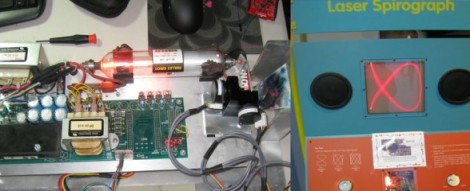That banner image may seem a little bit theatric, but it’s a good representation of what this 3W handheld laser can really do. Turn the thing on in a slightly smoky room and it looks exactly like a thin beam Lightsaber.
What kind of tricks would you expect this thing to perform? Perhaps it’ll pop some black balloons? Prepare to be shocked because it’s orders of magnitude more powerful than that. The video below shows it burning and igniting a collection of items almost instantly. [Styropyro] tested his creation by igniting paper, cardboard, flash paper, flash powder, burning through a stick of wood, and igniting an undisclosed substance at the end of the video. But one of our favorites is when he drives a solar powered toy car with the intense beam.
He pulled the diode from a DLP projector, and drives it with a pair of 18650 Lithium Ion batteries which are commonly found in laptops. He made the enclosure himself. It looks great but we can’t help but wonder if the components would fit in a painstakingly made replica.
Continue reading “3W Handheld Laser Raises Hope For A Real Lightsaber Someday”


















